Welcome to How to Lane Change
If you’re wondering how to lane change, you’re not alone. Lane changing can be quite a difficult thing for a beginner driver to get good at. A lot of beginners tend to slow down to think about things when they’re planning a lane change. Of course, this doesn’t work. Let’s get into some helpful pointers on how to safely lane change for new and experienced drivers alike.
Preparing for your ICBC road test? Be sure to check out my epic article: ICBC Road Test Tips For Classes 5 & 7 [Instructor Gets Deep].
Why do drivers need to learn how to lane change?
- Mostly because we are not supposed to turn right from the left lane, or turn left from the right lane
How To Lane Change
Are you wondering how to lane change? The normal lane-changing procedure usually goes like this:
- Mirror
- Signal
- Shoulder check
Mirror(s), Signal
First, you check your mirror(s) to find an available space beside-ish you. Then, you signal your intentions so that you are letting other drivers know what you are planning to do.
Shoulder Check
Then, you must shoulder check to make sure there isn’t anything in your blind spot. After all of this is done, you simply look ahead again and gently steer into your new lane while looking where you want to go. Check your mirror once in your new lane to make sure your new lane is still under control. I know, I made it sound kind of easy, didn’t I?
Why is Changing Lanes So Difficult?
Lane changing is one of the most difficult things for new learner drivers to master. It seems even experienced drivers don’t find it easy, either.
This is because, in lane changing, we often have to multitask
- We need the actual space in front of our new lane to move into
- We need space behind us so that the traffic behind has enough room and doesn’t rear-end us if we need to stop
- But we also have to notice things like lights going yellow or red
- Pedestrians in crosswalks
- Other drivers trying to lane change into the same space as you
- We also have to judge speeds. Your own speed, the speed of the vehicle in front and behind you
- Those speeds naturally change due to circumstances
- Oh, and we are supposed to be noticing everything that we are normally supposed to be noticing all at the same time. It can be a lot when you’re new at driving
How to Lane Change: Step-By-Step
Check your Mirrors
If there is no space in front of you in which to move, then there is no point in turning on your signal or doing a shoulder check. Find the space to move into first.
How Do You Know if You Have Enough Space
I see a lot of drivers cutting off others when doing a lane change.
This is dangerous because it leaves the vehicles no space in case of sudden stops (red light, pedestrians, etc.) It is also seen as being rude and can trigger road rage.
General guidelines for finding enough space
A general guideline I use when teaching new drivers how to tell if they have enough space is to look in their rear-view mirror.
What to see in the rear-view mirror
You need to be able to see the entire front of the vehicle behind you, including its tires, touching the pavement before you can even consider moving over in front of that vehicle.
If you can see that much space in your mirror, then you have a generous and safe amount of space between the vehicles. As long as you are going the same speed, that is a good guideline.
If you can not see the entire thing in your mirror or the tires – say you can see the windshield, but not the headlights – then don’t do it – You are too close.
Lane Changing Around Large Vehicles & Motorcycles

Trucks Can’t Stop Like Cars Do
This is especially important if the vehicle behind you is a large truck. If you lane change too close, and then suddenly stop, there is a good chance you’ll be rear-ended.
Trucks can not – and will not – stop in the same space that you can. Think about motorcycles as well. They can – and will – stop at a much shorter distance than you.
This means you could potentially rear-end them no matter how bad you don’t want to. So leave extra room in front and behind at all times. It’s motorcycle season all year in Vancouver.
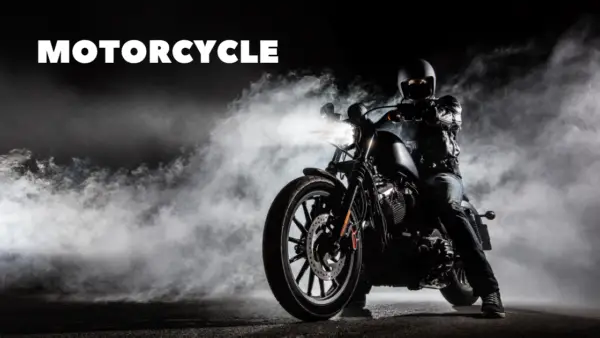
It should look something like the following photo, you want to see the whole vehicle and the tires touching the pavement in your rear-view mirror.
This is about three or four car lengths usually. If you don’t believe me, park your car in front of another car and Get Out And Look (GOAL…. LOL)
See at least this much space in the mirror – the entire car & tires touching pavement; more for a truck or larger vehicle.
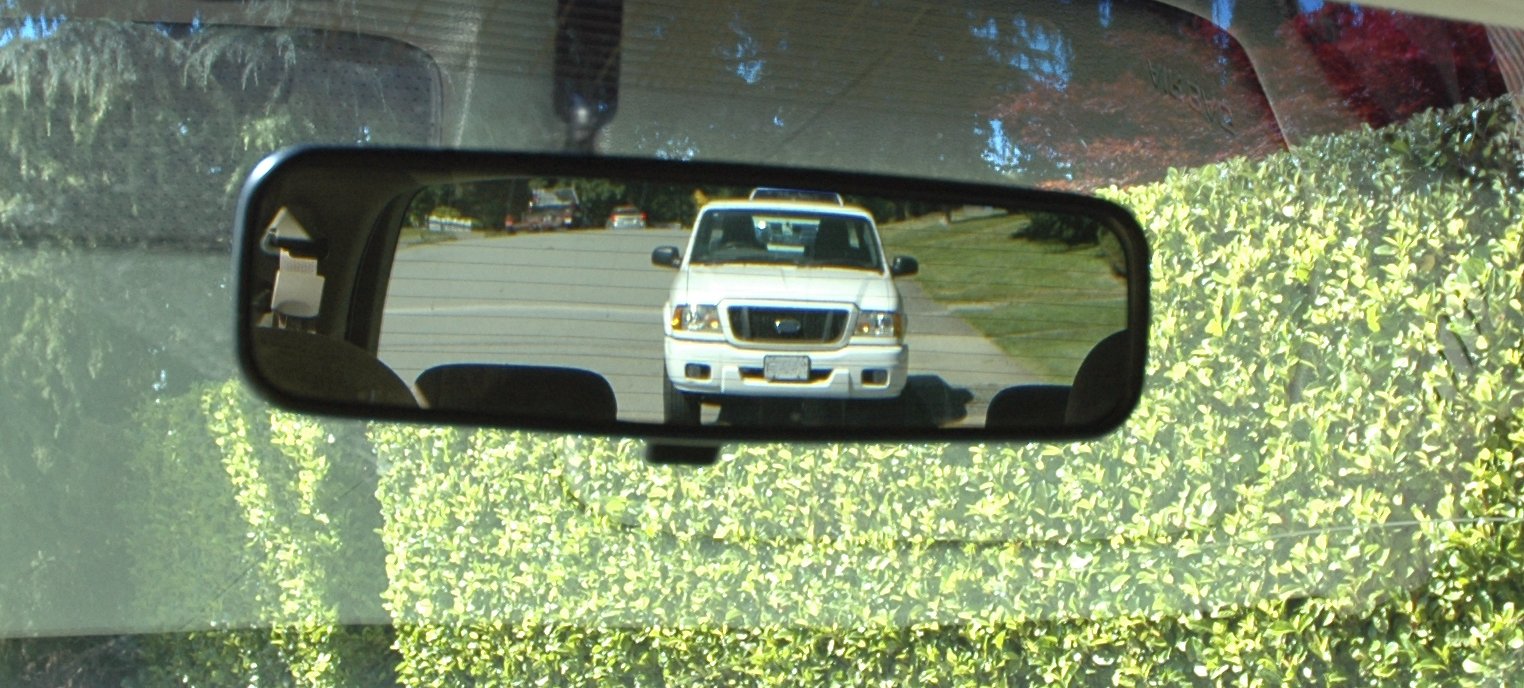
Signal Your Intent
Here’s the funny thing about the turn signal: many people seem to think that the only reason they need to signal is to avoid getting a traffic ticket and paying a fine. So they just put it on at the same time as the lane change to basically cover themselves; so they can say that they did it.
Think about it though.
You may know where you’re going, but others around you probably have no idea. Most of them are probably not physic. If you can’t find the space because there are too many cars, you can signal first. Drivers can help you much better when they know where you would like to go; where you plan to go; where, as a driver, you are thinking about going.
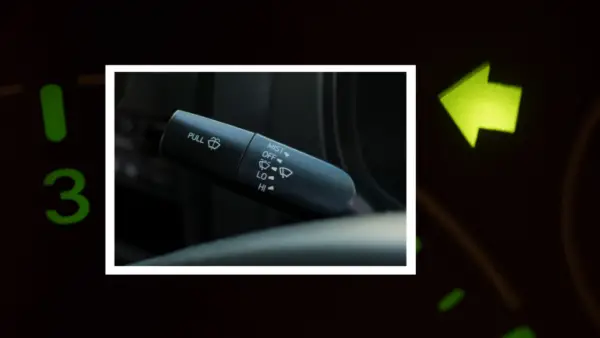
This is fine as long as the roads aren’t too busy, or don’t have too many lanes.
But if you don’t signal, and someone assumes you’re going straight because you don’t have a signal (and that is a logical assumption, isn’t it?) then you can easily get into trouble.
You should signal at least a few seconds before you actually shoulder-check and move your vehicle. This leaves some time going by that can warn other people that you are seriously thinking about moving your vehicle.
If someone else has a problem with your intentions (such as a motorcycle or a car you did not notice riding in your blind spot) then there will be some time for them to honk to alert you of their existence.
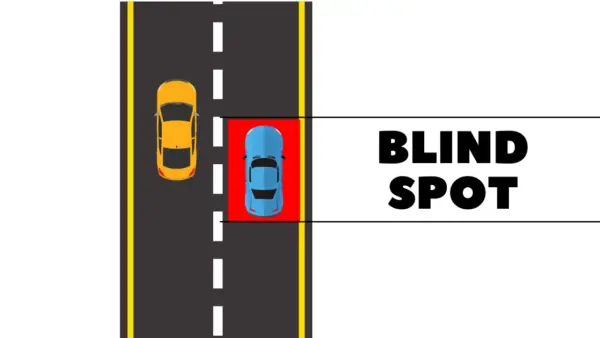
If you simply signal at the exact same time as you move over (which I also see is happening quite a lot) then there will be no time for anyone to alert you of the danger, and essentially your turn signal was 100% useless.
How To Lane Change – Think About These Two Examples
Say this little blue/green car is parked. It wants to enter the traffic. The red car in the left lane also wants to lane change around this time.
If neither car has a signal, because they think there is no potential conflict from anyone else, then they could potentially have a crash.
If they both signal their intentions before they move, even if one of them displays a signal, then the situation will be much safer.
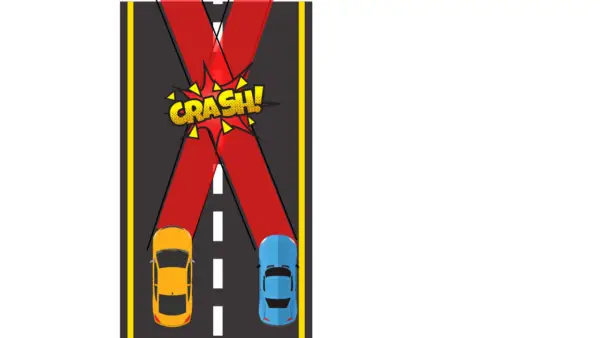
How To Lane Change on Multi-Lane Roads
When you’re driving on a road that has multiple lanes then you really need to time it so that when you are planning your lane change, there is not a car in the same position on the road two lanes over.
That driver, like you, maybe thinks that it’s also a wonderful time for them to move over into the middle lane. Great minds think alike, after all.
Remember: a collision is simply when two or more things try to enter the same space at the same time
In this case, signals may be useless
Signals are nice and all, but they’re only useful if the other drivers can actually see them, right?
To be a defensive driver, you need to slow down or speed up, or wait a bit longer until you aren’t in this precarious position. As drivers, we really do need to intentionally avoid “precarious positions.”
Never assume, “Oh, it’s probably fine.”
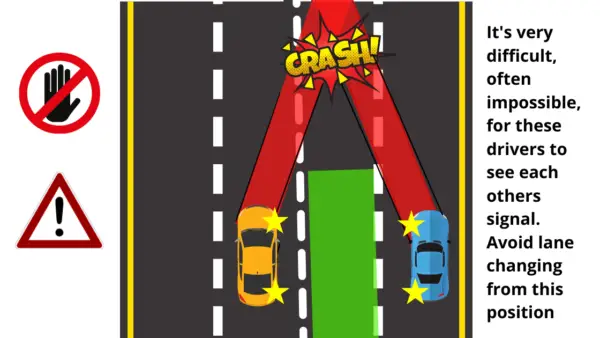
Safe Lane Changing Tips
Just as a reminder, you control your car and you control the speed of your car. You are driving your car, your car is not driving you.
This means you actually do control your space and spacing within the other vehicles. You can intentionally and strategically position your vehicle so that even if the other car changes lanes at the same time, it’s totally fine and safe.
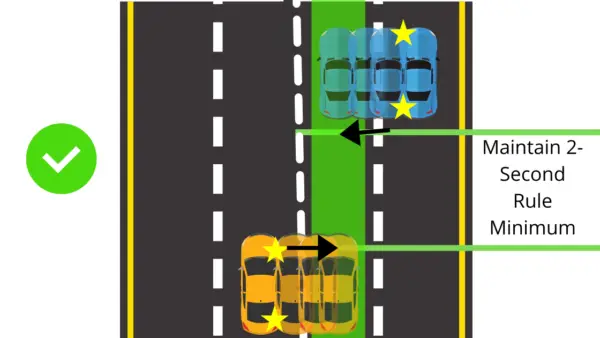
How to Lane Change in Heavy Traffic
In cases when you’re in heavy traffic, you’ll have to signal first. People have no idea that you would like to lane change unless you tell them.
In this case, you can signal first and leave the signal on, drive along for a bit and see if the car next to you will widen the gap for you. This is very simple for them to do.
Strategic Positioning for Lane Changing
This works best if you get your car into a strategic position of making it easy for the car (I mean, the driver) next to you to help you. People are actually good about this, if you ask nicely, and if you set it up nicely.
Maybe a lot of people won’t go out of their way for you (and should they have to?); if you set it up properly, it should be easy for all.
Make sure you’re in a position where the other driver can see your signal. If you are right beside another car, there is no way the driver is going to see your signal:

How To Lane Change: Strategic Vehicle Positioning
Get your car just a bit in front of the car so that they can see your signal – you want your turn signal light to be kind of flashing in front of their face, like a twinkling star in the cool and crispy night sky.
That is the most obvious and the best way to get their attention

In this case, the yellow car is saying to the blue car, “Excuse me, I would like to do a lane change sometime relatively soon, but I don’t have enough space. Could you please be so kind as to make the space in front of you a little bit bigger, by slightly easing off your accelerator pedal for a few moments?”
I know, I know. Canadians. We’re so friendly it hurts. If you are the person driving the blue car, it’s very simple to ease off your accelerator and allow the car enough room.
I have taught people how to do lane changes in this manner regularly and with ease. People are usually very happy to help you, especially when you made it easy for them.
You must be going the exact same speeds, otherwise, it’s not going to work. Make sure you wait a few seconds after you put your signal on – until you can see the entire car in the mirror as mentioned – to make sure you aren’t cutting them off.
Remember to keep your eyes moving to watch the traffic in front of you in case of red/yellow lights or sudden unexpected stops. If the car lets you in, say thanks with a wave. If he doesn’t, then you can not lane change.
Fault in Lane Changing Collisions
Try again with a different car. Legally, you must not lane change until it is safe. He who leaves his lane and crashes into something who was minding their own business in another lane will be found at fault for lane-changing collisions.
If you leave your lane and get into a crash, then it will be your fault. If two cars both leave their lane at the same time and have a crash, then the fault will likely be 50/50.
Shoulder Check for Lane Changing, Always
Shoulder Check. This should take less than one second and you should be moving your head only (not your whole body or shoulders).
Most cars have a blind spot out of the rear passenger window area on each side of the vehicle. If your car has the fancy new blind spot warning system, well then you may have a good argument against shoulder checking.
Taking your eyes off the road for any period of time is considered dangerous. That’s because things can and do change within split seconds. That’s why we must use the mirrors first, and then make the shoulder check very quick.
Maybe you’re sure there’s nothing there, in the blind spot. But what if one day you are wrong? If it saves a life, is it worth it? Remember that we can not undo car crashes. If we’re going to stop them, we have to prevent them before they had a chance.
New Driver Issues
*New drivers often shoulder check and move into the new lane at the exact same time. Please be aware of this issue when learning and practicing doing these steps one after the other, not all at the same time.
You should be staying 100% completely in your lane while shoulder-checking. Then, look forward again. Then, move over while looking at where you’re going.
How To Lane Change – Make Your Move
Move into your new lane! Check your rear-view mirror again to see what’s going on in your new lane. How is the vehicle behind? Are they too close? Should you leave more room in front of you? Is there an emergency vehicle approaching?
Solid White Lines when Lane Changing
*Keep in mind it’s illegal to lane change over a solid white line. Avoid lane changing in intersections (not actually illegal, but not a good idea either).
How To Lane Change – Conclusion
Lane changing can be difficult for new and experienced drivers alike. This is because of a few things, one of which is the need to multitask.
You need to judge speed and distances, that are in front and behind you, at the same time, and keep your other eye – not that you have that – on where you’re going.
There are also yellow lights and cars that drive at spontaneous, sporadic, and/or erratic speed patterns that can complicate everything, like, seriously. It just ain’t easy. However, with practice, it gets easier, just like everything else. It does take about five years for a new driver to get to the skill level of the average driver.
Related:
- What to Bring to the Road Test & Fees
- Car Rental & Car Sharing Options
- Get Your ICBC Drivers Abstract FREE (Driving Records)
Carmen Cohoe
Carmen became a driving instructor in beautiful North Vancouver at the age of 22 due to some crazy people who agreed to hire her. After that, there was never a dull moment teaching many different folks from many different places how to drive using automatic and standard vehicles and a minivan.

Thanks for the tips changing lanes while driving; that can be a hard thing to do when in busy traffic. Someone recently told me that changing lanes was one of the main causes of auto accidents. I agree that you should position your car in a place that will allow other drivers to see your signal; that way they know what you are trying to do.
So when changing lanes I look at my rearview mirror and if I can see the entire vehicle and its tires in the lane im trying to change into it is generally safe to go in?
Yes generally; check the blind spot of course. Also, consider the speed of the vehicles. IF the other vehicle is proceeding faster than you are, then it’s probably not going to work! Otherwise, go for it. If you park your car somewhere so that you can see the entire vehicle of a parked car behind yours and then get out and see how much space is there, you will find that it is much larger than it looks in the mirror.. an acceptable distance so ensure safety so that if you change lanes and then have to stop (for a red light for example) then the car behind has enough room it won’t rear end you, will be able to stop in time and also, it’s not rude (you are not “cutting them off”)
Hope that helps..
Also, what is the proper way to adjust the rear view mirror
Oh, just adjust it so that you can see what is directly behind you. You can use your side mirrors and shoulder checks to see everything else. Hope that makes sense.
So then you would actually be looking into your side mirror to see the front of the car and its tires in the lane next to you?? NOT the rear view mirror that allows you to see directly behind you.
Hi… well you can see the vehicle in both mirrors, but I would use the rear-view mirror as the guide… so if you can see the entire vehicle in your rear-view mirror then it’s enough space.. the side mirrors are often convex (distorted).
But we should still be using our side mirrors of course? Because there are cars that go out of frame from the rear view and show up in the side only.
yes I would say it is wise to use a combination of the mirrors.
Hi. Im a new driver and I have some questions if you could help.
1. So if you see no car in your passenger side window when checking your blind spot, that means its ok to go?
2. What if a car isn’t next to you but really close to the back of your bumper and you can’t speed up cause you’re driving the speed limit of 30mph, do you slow down to let them pass you? (I thought its bad to slow down to change lanes) but I don’t see any other way.
3. So if you check your rear view mirror into the lane you want to go into and you see their headlights + tire, you’re good? I heard some people use their side mirrors for this method too but it’s not a true view so why do we need to check our side mirrors for changing lanes?
Thank you.
Hmm, it is kind of difficult to teach lane changing over the internet, let alone to learn it in real life. It is quite a difficult skill for a lot of new drivers to learn; lessons can help a lot.
1. Well not necessarily! There could be speeding traffic coming from behind you or in the other lane. You have to be aware of what is going on around your car all the time. Things change very quickly too. One moment there may be no traffic and the next moment there may be a speeding car coming behind you.
2. In this case I would recommend using your turn signal! Let the car know you want to lane change, otherwise, he doesn’t know. You’re right you won’t want to speed.. Sometimes you might slow down a little bit, preferably you signal and create the space first and then move over going the same speed as traffic.
3. Not necessarily. This is a general guideline. It all depends on the speed of the cars. If the car behind you is going much faster than you then this isn’t going to work. If you are going the same speed and you also check mirrors and do a shoulder check to make sure there is nothing in the blind spot then this is a good guideline to ensure there’s enough space between the vehicles before you move, just in case you change lanes and need to stop for a yellow light, pedestrian or any other reason, this gives the vehicle behind you his proper 2-3 second of following distance needed for safety. Different mirrors show you different views, so it’s good to check the rear-view and also the side mirror to find adequate space. And of course don’t forget the shoulder check! Remember there are still small vehicles and motorcycles that could hide in your blind spot very easily.
I always turn my whole body to shoulder check, and I tend to shoulder check and simultaneously move into the next lane. I guess I’m afraid that after doing the shoulder check, a car might suddenly appear.
thank you very much for detail analys of this fundamental driving skill
You’re very welcome